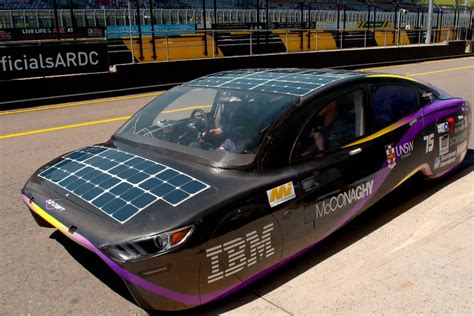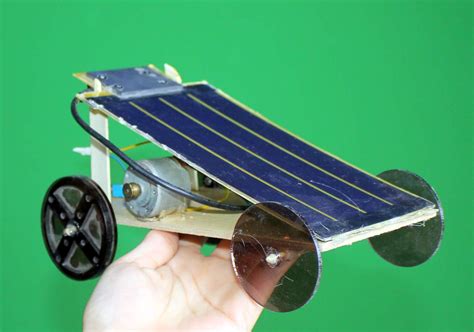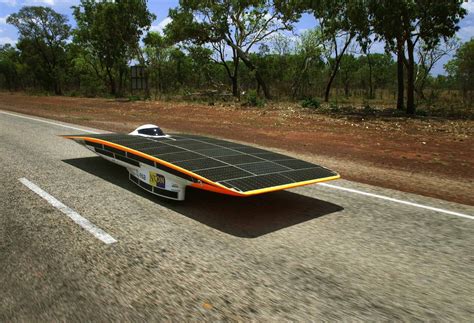Introduction to Solar Cars
Solar cars are vehicles that are powered by energy from the sun. They use photovoltaic (PV) cells to convert sunlight into electricity, which is then used to power an electric motor that drives the car’s wheels. Solar cars are a promising technology for sustainable transportation, as they produce no emissions and rely on a renewable energy source.
The concept of solar-powered vehicles has been around since the 1950s, but it wasn’t until the 1980s that the first practical solar cars were developed. Since then, advances in PV technology, battery storage, and aerodynamic design have made solar cars increasingly efficient and capable of longer distances.
How Solar Cars Work
Solar cars use PV cells, which are typically made of silicon, to convert sunlight into electricity. When light hits the PV cells, it excites electrons and generates a flow of electrical current. This current is then used to charge a battery pack, which stores the energy for later use.
The battery pack powers an electric motor, which drives the car’s wheels. Solar cars also have a controller that regulates the flow of electricity from the battery to the motor, ensuring optimal performance and efficiency.
Advantages of Solar Cars
Solar cars have several advantages over conventional gasoline-powered vehicles:
- Zero emissions: Solar cars produce no tailpipe emissions, making them an environmentally friendly transportation option.
- Renewable energy source: Solar energy is abundant and renewable, meaning that solar cars can be powered indefinitely without depleting finite resources like fossil fuels.
- Low operating costs: Once a solar car is built, its operating costs are minimal, as it requires no fuel and little maintenance.
- Quiet operation: Electric motors are much quieter than internal combustion engines, resulting in reduced noise pollution.
Challenges Facing Solar Cars
Despite their advantages, solar cars face several challenges that have limited their widespread adoption:
- Limited range: Solar cars are currently limited in their range due to the amount of energy that can be stored in their battery packs and the efficiency of their PV cells.
- Dependence on weather: Solar cars rely on sunlight to generate electricity, which means that their performance can be affected by cloudy or rainy weather.
- High upfront costs: The advanced technology used in solar cars, such as high-efficiency PV cells and lightweight materials, can make them more expensive than conventional vehicles.
- Infrastructure: There is currently limited infrastructure in place to support solar cars, such as charging stations and maintenance facilities.
The Midnight Sun Solar Design Team
The Midnight Sun Solar Design Team is a group of engineering students at the University of Waterloo in Canada who are pioneering the development of advanced solar cars. Founded in 1988, the team has built 13 solar cars and competed in numerous international competitions, including the World Solar Challenge and the American Solar Challenge.
History and Achievements
The Midnight Sun team has a long history of innovation and success in solar car racing. Some of their notable achievements include:
- 1990: Built their first solar car, Midnight Sun I, and competed in the GM Sunrayce USA
- 1993: Achieved a top speed of 109 km/h with Midnight Sun II
- 1996: Placed 2nd in the World Solar Challenge with Midnight Sun IV
- 2000: Set a Guinness World Record for the longest journey by a solar-powered car with Midnight Sun VI, traveling 15,070 km across Canada
- 2005: Placed 3rd in the North American Solar Challenge with Midnight Sun VIII
- 2015: Achieved the highest score for practicality and placed 9th overall in the World Solar Challenge with Midnight Sun XI
Current Projects and Goals
The Midnight Sun team is currently working on their 14th solar car, Midnight Sun XIV, which they plan to race in the 2023 World Solar Challenge. The team’s goal is to design and build a solar car that pushes the boundaries of efficiency, practicality, and performance.
Some of the key features of Midnight Sun XIV include:
- Lightweight carbon fiber chassis and body panels
- High-efficiency gallium arsenide PV cells
- Custom-designed battery pack with advanced management system
- Regenerative braking system to capture energy during deceleration
- Aerodynamic design optimized using computational fluid dynamics (CFD) simulations
In addition to competing in solar car races, the Midnight Sun team is also focused on advancing solar car technology and promoting sustainable transportation. They regularly collaborate with industry partners and academic researchers to develop new technologies and share their knowledge with the wider community.

Solar Car Competitions and Events
Solar car competitions and events provide opportunities for teams like Midnight Sun to showcase their vehicles, compete against other teams, and promote the development of solar car technology. Some of the most notable solar car events include:
World Solar Challenge
The World Solar Challenge (WSC) is the world’s oldest and most prestigious solar car race, held every two years in Australia. Teams from around the world compete in a 3,000 km race from Darwin to Adelaide, traversing the Australian outback.
The WSC has several different classes of vehicles, including:
- Challenger Class: Single-seat, ultra-efficient solar cars designed for speed
- Cruiser Class: Multi-seat, practical solar cars designed for efficiency and practicality
- Adventure Class: Non-competitive class for solar cars built for previous events
The Midnight Sun team has competed in the WSC several times, achieving a best finish of 2nd place in the Challenger Class in 1996.
American Solar Challenge
The American Solar Challenge (ASC) is a solar car race held in North America, typically covering a distance of 1,500-2,000 miles (2,400-3,200 km) across multiple states. The race is open to university and college teams from around the world.
The ASC has a similar format to the WSC, with Challenger and Cruiser classes of vehicles. The Midnight Sun team has competed in the ASC multiple times, including a 3rd place finish in the Challenger Class in 2005.
Other Events and Exhibitions
In addition to competitive races, there are also several other events and exhibitions that showcase solar cars and promote sustainable transportation, such as:
- The Solar Car Conference: An annual conference that brings together solar car teams, researchers, and industry professionals to share knowledge and collaborate on new technologies
- The EV & Hybrid Expo: A trade show that showcases the latest developments in electric and hybrid vehicles, including solar cars
- The Green Living Show: A consumer-focused event that promotes sustainable products and technologies, including solar-powered transportation
These events provide opportunities for the Midnight Sun team and other solar car teams to engage with the public, demonstrate their vehicles, and raise awareness about the potential of solar energy for transportation.

Solar Car Technology and Innovation
The development of solar cars has driven significant advances in several areas of technology, including photovoltaics, energy storage, and aerodynamics. Some of the key technological innovations in solar cars include:
High-Efficiency Photovoltaic Cells
Solar cars rely on high-efficiency PV cells to convert sunlight into electricity. While traditional silicon PV cells have efficiencies around 20%, advanced multi-junction cells made from materials like gallium arsenide can achieve efficiencies over 30%.
The Midnight Sun team has experimented with several types of PV cells in their vehicles, including:
- Monocrystalline silicon cells
- Gallium arsenide cells
- Perovskite cells
By using high-efficiency PV cells, solar cars can generate more electricity from a smaller surface area, improving their overall performance and practicality.
Lightweight Materials
To maximize their efficiency and performance, solar cars are typically built using lightweight materials like carbon fiber, aluminum, and titanium. These materials provide high strength and stiffness while minimizing weight, allowing solar cars to accelerate and maintain high speeds with less energy.
The Midnight Sun team has developed expertise in working with carbon fiber composites, using them to construct the chassis, body panels, and other components of their vehicles. They have also experimented with advanced manufacturing techniques like 3D printing to create lightweight, optimized parts.
Advanced Battery Technology
Solar cars rely on battery packs to store the energy generated by their PV cells and power their electric motors. Advances in battery technology, including lithium-ion and lithium-polymer chemistries, have enabled solar cars to store more energy in smaller, lighter packages.
The Midnight Sun team has developed custom battery packs for their vehicles, using advanced battery management systems to optimize their performance and safety. They have also explored the use of supercapacitors to provide high-power bursts for acceleration and regenerative braking.
Aerodynamic Design
Aerodynamic drag is a significant factor in the efficiency and performance of solar cars, as it can account for a large portion of the vehicle’s energy consumption at high speeds. Solar car teams use advanced computational fluid dynamics (CFD) simulations and wind tunnel testing to optimize the shape and surface of their vehicles for minimal drag.
The Midnight Sun team has developed a distinctive “catamaran” style body shape for their vehicles, which provides a balance of aerodynamic efficiency and stability. They have also used CFD simulations to optimize the placement of their PV cells and other components to minimize drag and maximize energy capture.

The Future of Solar Cars
While solar cars are still a niche technology, they have the potential to play a significant role in the future of sustainable transportation. As PV efficiencies continue to improve and battery costs decrease, solar cars could become increasingly practical and affordable for everyday use.
Market Potential
There are several potential markets for solar cars, including:
- Commuter vehicles: Solar cars could be used for short-distance commuting, particularly in urban areas with good solar exposure.
- Fleet vehicles: Organizations with large fleets of vehicles, such as delivery companies or government agencies, could use solar cars to reduce their fuel costs and emissions.
- Developing countries: Solar cars could provide affordable, sustainable transportation in regions with limited access to fossil fuels and electricity.
Integration with Other Technologies
Solar cars could also be integrated with other sustainable transportation technologies, such as:
- Electric vehicle charging: Solar-powered charging stations could be used to recharge electric vehicles, reducing their reliance on grid electricity.
- Autonomous driving: Solar cars could be combined with autonomous driving technology to create self-driving, self-charging vehicles.
- Smart grids: Solar cars could be integrated with smart grid technology, allowing them to store and discharge energy as needed to balance supply and demand.
Policy and Infrastructure
The widespread adoption of solar cars will require supportive policies and infrastructure, such as:
- Tax incentives and subsidies for solar car purchases and manufacturing
- Investment in solar-powered charging infrastructure
- Regulatory frameworks for the safety and performance of solar cars
- Public education and awareness campaigns to promote the benefits of solar transportation
Frequently Asked Questions (FAQ)
1. How far can solar cars travel on a single charge?
The range of a solar car depends on several factors, including the efficiency of its PV cells, the capacity of its battery pack, and the weather conditions. Some solar cars have achieved ranges over 1,000 km on a single charge under ideal conditions, while others may have a range of only a few hundred kilometers.
2. How fast can solar cars go?
Solar cars are typically designed for efficiency rather than speed, but some can still achieve impressive velocities. The fastest solar cars in the World Solar Challenge have reached speeds over 130 km/h (80 mph), while the record for the highest speed achieved by a solar car is over 160 km/h (100 mph).
3. How much do solar cars cost?
Solar cars are currently very expensive due to the advanced technology and custom components used in their construction. The cost of a competitive solar car can range from $100,000 to over $1 million, depending on the team and the class of vehicle. However, as solar car technology becomes more mature and widespread, costs are likely to decrease.
4. Can solar cars be used in cloudy or rainy weather?
Solar cars can still operate in cloudy or rainy weather, but their performance will be reduced due to the lower amount of solar energy available. Most solar cars are equipped with battery packs that can store energy for use during periods of low sunlight, allowing them to continue driving even in suboptimal conditions.
5. Are solar cars practical for everyday use?
Currently, solar cars are not practical for everyday use due to their limited range, high cost, and lack of infrastructure. However, as solar car technology continues to advance and costs decrease, they may become a more viable option for daily transportation, particularly for short commutes in areas with good solar exposure. The integration of solar technology with other sustainable transportation solutions, such as electric vehicles and autonomous driving, could also make solar cars more practical and accessible in the future.
Conclusion
Solar cars are a promising technology for sustainable transportation, offering the potential for zero-emission, renewable energy-powered vehicles. The Midnight Sun Solar Design Team is at the forefront of this technology, developing advanced solar cars that push the boundaries of efficiency, practicality, and performance.
Through their participation in competitions like the World Solar Challenge and the American Solar Challenge, the Midnight Sun team is helping to drive innovation in solar car technology and promote the benefits of sustainable transportation. Their current project, Midnight Sun XIV, represents the cutting edge of solar car design, with advanced features like high-efficiency PV cells, lightweight materials, and optimized aerodynamics.
As solar car technology continues to evolve and mature, it has the potential to play a significant role in the future of transportation. With supportive policies, infrastructure, and public awareness, solar cars could become an increasingly practical and affordable option for everyday use, helping to reduce our reliance on fossil fuels and combat climate change.
The work of teams like Midnight Sun is crucial in advancing this technology and demonstrating its potential to the world. Through their dedication, innovation, and passion for sustainable transportation, they are helping to pave the way for a cleaner, greener future powered by the sun.

No responses yet